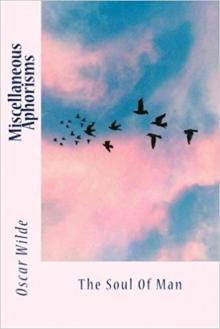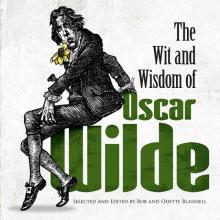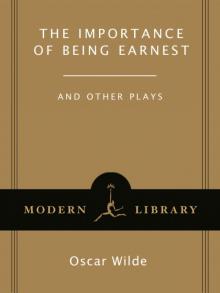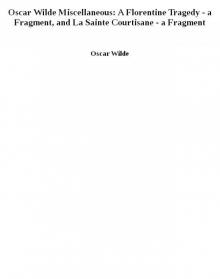- Home
- Oscar Wilde
The Short Stories of Oscar Wilde Page 2
The Short Stories of Oscar Wilde Read online
Page 2
Five of the stories gathered here were classified by their author as fairy tales, as examples of “things that do not concern us” or of what Wilde later called “reactions against the crude brutality of plain realism,” and they contain some of the finest prose Wilde ever produced.31 They are also models of the storyteller’s art. Wilde thought carefully about matters of form and style, and he took as much care over each sentence as he did over the narrative arc as a whole. “Language requires to be tuned like a violin,” he once remarked, echoing his dicta that thought and language are to the creative writer merely “instruments of an art” and that “from the point of view of form, the type of all the arts is the art of the musician.”32 Again Wilde’s direct comments on his own stories are instructive: “my stories … are studies in prose, put for Romance’s sake into a fanciful form,” he told Kersley. “I did not start with an idea and clothe it in a form,” he told Thomas Hutchinson, a schoolteacher, “but began with a form and strove to make it beautiful enough to have many secrets, and many answers.”33 He was immensely gratified when Walter Pater, perhaps the greatest prose writer of his day, wrote to him privately praising the Happy Prince stories as “poems in prose” and “gems” and adding that the book “abounds with delicate touches and pure English.” The phrase “poems in prose” would have been especially gratifying to Wilde because he had started his literary career wanting to be a poet, and he would later experiment with the form of the prose poem at the height of his success as a popular playwright.34
This concern with the formal and poetic possibilities of prose does much to explain why Wilde, whose earliest literary works were (not always successful) experiments in poetry and drama, turned to the composition of fiction in the mid-1880s. “Prose so fascinates me, that I prefer to sit at its organ than to play on the pipe or reed,” he told the poet Ernest Radford.35 Wilde’s turn to prose fiction is sometimes explained by his 1884 marriage to Constance Lloyd—by the urgent need to make money that came with his new status as husband, householder, and parent, as well as by his professional involvements with the world of popular serials in the years immediately following his marriage.36 Even before his marriage, however, Wilde was interested in moving beyond the genres of poetry and drama: in 1883, four years before the publication of his first story, he told Robert Sherard that “the rhythmical value of prose has never yet been fully tested” and that he hoped to “do some more work in that genre.”37 The short fiction gathered in this collection represents the fulfillment of his promise to Sherard.
Whatever else we might say about Wilde’s short stories, the “rhythmical value” of his prose immediately strikes and delights us on reading them. Wilde greatly admired the work of the French poets Charles Baudelaire and Théophile Gautier, as well as the novelist Gustave Flaubert. Shortly after publishing The Happy Prince, he told W. E. Henley that “to learn how to write English prose I have studied the prose of France,” calling Flaubert “my master.”38 He even asked the publisher of The Happy Prince whether he’d be interested in publishing a translation of Flaubert’s novel La Tentation de St. Antoine (The Temptation of St. Anthony).39 As an ardent Francophile, moreover, he can hardly have been unaware of the publication in 1886 of Illuminations, by the contemporary French poet Arthur Rimbaud, a book second only to Baudelaire’s Paris Spleen (1869) as a model for future prose poets. To be sure, the rhythms of Wilde’s stories about contemporary fashionable life are not those of prose poetry but those of English speech and conversation: with their witty aperçus and epigrams, “Lord Arthur Savile’s Crime” and “The Model Millionaire” have more in common with Wilde’s society plays than with the prose poem as it’s commonly understood. But from “The Happy Prince” onward, Wilde’s short fiction is inflected by a different kind of music:
“Swallow, Swallow, little Swallow,” said the Prince, “far away across the city I see a young man in a garret. He is leaning over a desk covered with papers, and in a tumbler by his side there is a bunch of withered violets. His hair is brown and crisp, and his lips are red as a pomegranate, and he has large and dreamy eyes. He is trying to finish a play for the Director of the Theatre, but he is too cold to write any more. There is no fire in the grate, and hunger has made him faint.”
… All the next day [the Swallow] sat on the Prince’s shoulder, and told him stories of what he had seen in strange lands. He told him of the red ibises, who stand in long rows on the banks of the Nile, and catch gold fish in their beaks; of the Sphinx, who is as old as the world itself, and lives in the desert, and knows everything; of the merchants, who walk slowly by the side of their camels, and carry amber beads in their hands; of the King of the Mountains of the Moon, who is as black as ebony, and worships a large crystal; of the great green snake that sleeps in a palm-tree, and has twenty priests to feed it with honey-cakes; and of the pygmies who sail over a big lake on large flat leaves, and are always at war with the butterflies.
The language of Wilde’s fairy tales is based on rhythm, pattern, and sharp imagery, on the carefully measured repetition and variation of distinct verbal motifs, refrains, and other devices more commonly found in poetry. If “the fine flower of prose-writing” is “the beautiful architecture of a long sentence,” as Wilde once remarked, his fairy tales contain many such flowers.40 It is easy to see why Pater—who insisted that prose writers should harness “all that latent colour and imagery which language as such carries in it” and bemoaned the “degradation of language of those who treat coloured glass as if were clear”41—so admired Wilde’s short fiction. “In these stories … [Wilde] is at his best,” remarked the distinguished American satirist and critic H. L. Mencken: “I know of no modern English that projects color and warmth and form more brilliantly, or that serves more nobly the high purposes of beauty.”42 Along with the writings of John Ruskin, Vernon Lee, and Pater himself, Wilde’s stories are consummate examples of the “aesthetic” prose to which many late-Victorian writers aspired.
In tandem with Wilde’s efforts to harness the color and imagery of language, the printed books in which his fairy tales appeared are now considered important expressions of the bookmaker’s art, historically notable for their arresting illustrations, brightly colored bindings, and groundbreaking graphical experiments. If the artist was the creator of beautiful things, it was a matter of supreme importance to Wilde that his writings should reach readers in formats that properly incarnated the artistry of his language. “The marvels of design stir the imagination,” he wrote in 1890; “In the mere loveliness of the materials employed there are latent elements of culture.”43 “What we need is good book ornament,” he proclaimed a few months after the publication of The Happy Prince, “decorative ornament that will go with type and printing, and give to each page a harmony and unity of effect … Our aim should be to discover some mode of illustration that will harmonise with the shapes of our letters.”44
The original designs of Wilde’s books of fairy tales bear out these ideas, and the designers and illustrators were handpicked by Wilde himself. The cover of The Happy Prince, made of creamy Japanese vellum, features a striking calligraphic arrangement printed in red below a black and white pictorial device by Jacomb-Hood. The book’s paper and typography are fine, and as we have seen, Wilde was proud of the involvement of Jacomb-Hood and Crane, the latter of whom was probably the most prominent and highly regarded British book illustrator of the 1880s. The design of A House of Pomegranates, by Charles Ricketts and his partner Charles Shannon, is even more striking: the book has an unusual cloth binding of cream-colored boards and a green linen back, containing an elaborate design by Ricketts stamped in red ink and gilt. Its page layouts are experimental,45 and other unusual and arresting elements include a hand-drawn pictorial title-page, colored patterned endpapers, and numerous decorative vignettes and page ornaments alongside more conventional full- and half-page illustrations by both Ricketts and Shannon.46 The book’s design was immediately controversial, leading Wilde to defend its “artistic beauty
” in the press.47 Ricketts—who went on to design many notable books in the 1890s, including the “Author’s Edition” of Wilde’s Poems (1892) and Wilde’s The Sphinx (1894)—later felt that A House of Pomegranates was one of many “early experiments in the shaping of books” that he now found “crude … hesitating … [and] not always strictly shaped according to my wishes.” But some of Ricketts’s illustrations and page ornaments are as arresting today as when they first appeared. Like Walter Crane, Ricketts was an important inspiration to later designers and illustrators—John Russell Taylor calls him “the hero of any study of the art nouveau book”—and A House of Pomegranates is now recognized as being one of the most gorgeously designed trade books of the nineteenth century.
If Wilde’s stories are consummate examples of his dictum that the artist is the creator of beautiful things, however, it would be a mistake to judge them from the standpoint of verbal or printed artistry alone. If their form is “remote from reality,” they are attempts nonetheless to “mirror modern life” and “deal with modern problems,” as Wilde himself acknowledged. A number of scholars have pointed to the concern with social and economic justice that runs through The Happy Prince, in which many stories turn on the inequities that structured late-Victorian Britain. Unlike the Happy Prince, whose happiness is an illusion masking his terrible disquiet at all that he sees around him, the civic leaders in “The Happy Prince” have no interest in ameliorating the grave injustices on plain view in their city. So, the Happy Prince is left to give away pieces of his rich self until he has nothing left to give. By contrast, the protagonist of “The Selfish Giant” is a fierce protector of his private property: he constructs a high wall around his beautiful garden, on which he places a noticeboard that reads “Trespassers will be prosecuted.” (Knowing that his readers would be familiar with such noticeboards, Wilde even mimicked the board’s form and layout in his typography.) As a result, the poor children are left to play on the road—except that the road proves dusty and full of hard stones, obliging the children to wander longingly instead around the giant’s high-walled property while reflecting on the theft of their happiness. As the annotations in this volume show, “The Happy Prince” and “The Selfish Giant” have obvious connections to Wilde’s 1891 political essay “The Soul of Man under Socialism,” in which Wilde develops a forceful, cogent critique of private property and misguided philanthropy while calling for a radical reconstruction in the organization of society.
A concern with social and economic injustice is detectable in Wilde’s “society” stories too. “Lord Arthur Savile’s Crime,” “The Model Millionaire,” and “Lady Alroy,” originally published in weekly magazines aimed at genteel and socially aspirant readers, all concern the idle rich of modern England and are set against a backdrop of urban poverty to which the leading characters themselves are largely blind or indifferent.48 (The title “The Model Millionaire” is typically tongue-in-cheek, since Baron Hausberg, the millionaire in question, cares nothing to ameliorate the poverty that he so evidently sees—to him a beggar is merely the “model” for a Rembrandtesque painting—and his generosity is directed only towards members of his own class.) Similarly, Lord Arthur Savile briefly sees “the crooked-back forms of poverty and eld” for the first time when he flees Bentinck House. But it is the “comedy” of suffering that strikes him as he ventures into unfamiliar neighborhoods on foot, its “absolute uselessness [and] grotesque want of meaning,” and it comes as no surprise when he puts all thought of poverty behind him, returns to Belgrave Square, the most aristocratic of London neighborhoods, and dedicates his life to winning the hand of Sybil Merton by any means necessary. For all the witty repartee they contain, these stories contain subtle critiques of the landed aristocracy of Wilde’s day. They anticipate the biting social criticism that lurks just beneath the surface of The Importance of Being Earnest; and what the critic Regenia Gagnier says of Wilde’s most famous social comedy—that Wilde himself was perfectly “aware of how trivial, vicious, and self-deluded was the Society [he] represented” and “both entertained and attacked a consummately bored upper class”—is no less true of “Lord Arthur Savile’s Crime,” “The Model Millionaire,” and “Lady Alroy.”49
The abuse or neglect of children is another pressing theme. The Selfish Giant undergoes a miraculous transformation in his empathy for neglected children, resolving ultimately to demolish his wall so that his garden might become their playground forevermore. But children in other stories aren’t so lucky: the Happy Prince instructs the Swallow to pluck out his remaining eye, which is made of sapphire, and take it to the match-girl because he knows that her father “will beat her if she does not bring home some money, and … she has no shoes or stockings.” Her reaction to the gift (“what a lovely bit of glass”) does little to allay our fear that she has not received her last beating at the hands of her father. She is not the only victim of such treatment: a “sensible mother” does nothing to calm her crying child, instead asking him rhetorically “Why can’t you be like the Happy Prince?” The “Mathematical Master” who supervises a group of charity children—a distant cousin of Charles Dickens’s Gradgrind and Charlotte Brontë’s Brocklehurst—only frowns and looks severe when his charges say they’ve seen angels in their dreams “for he did not approve of children dreaming.” And the young protagonist of “The Birthday of the Little Princess” is, for all the wealthy trappings surrounding her, the victim of severe emotional neglect at the hands of her widowed father, who wants nothing to do with her on her twelfth birthday (or on any other day), as “the shrill laughter of … children grated on his ears.” It is all too easy to condemn the princess for her own lack of empathy with others. But she is a product or expression of her isolated, privileged upbringing, and a close cousin of the Happy Prince, who tells the Swallow, “when I was alive and had a human heart … I did not know what tears were, for I lived in the Palace of Sans-Souci, where sorrow is not allowed to enter. In the daytime I played with my companions in the garden, and in the evening I led the dance in the Great Hall.” As Wilde argues in “The Soul of Man under Socialism,” immense wealth “has debarred one part of the community from being individual by … putting them on the wrong road and encumbering them.” It is no surprise that Wilde’s little princess is so emotionally stunted; while over the course of the story Wilde invites our sympathies for the dwarf whose love for her is so terribly and tragically misbegotten, Wilde does not represent the little princess for the purposes of moral condemnation, so much as to test the limits of his readers’ own powers of pity and empathy with a child.
The social inequities of hierarchical society and the abuse or neglect of children aren’t the only “modern problems” with which Wilde deals. A subtle homoeroticism pervades many of Wilde’s earliest stories, and it is conspicuous, too, how many of them concern the tragedy of unrequited, misplaced love. “You have stayed too long here, but you must kiss me on the lips, for I love you,” the Happy Prince tells the decidedly masculine Swallow at the denouement of the story bearing his name.50 However, the Swallow, who has previously renounced his “lady-love” and given his life in service to the prince, falls dead upon kissing the latter’s lips, whereupon the prince’s lead heart breaks in two. “Here at last is a true lover,” proclaims the Nightingale of “The Nightingale and The Rose” after hearing the student lament that he has no red rose with which to woo the professor’s daughter. The Nightingale lays down her life that he may possess such a rose, coloring it with her own lifeblood and singing, as her life ebbs away, of “the Love that is perfected by Death, of the Love that dies not in the tomb.” But the student is oblivious to her sacrifice and the professor’s daughter cares neither for roses nor for the student, while the latter ends up deciding that love is silly and “not half as useful as Logic.” (As Wilde wrote to a correspondent, “the nightingale is the true lover if there is one. She at least is Romance, and the student and the girl are, like most of us, unworthy of Romance.”)51 The fatality of lov
e and the misplaced nature of the nightingale’s romanticism couldn’t be more sharply defined.
A homoerotic undertone is present in “The Model Millionaire” and “Lady Alroy,” too. We overlook to our cost Wilde’s throwaway remark in “The Model Millionaire” about the basis of the friendship between the painter Alan Trevor and the brainless, conservative Hughie Erskine—that Trevor “had been very much attracted by Hughie at first … entirely on account of his good looks.” (On republishing the story in 1891, a year after the public outcry over The Picture of Dorian Gray, Wilde altered “good looks” to the less incriminating “personal charm.”) Hughie’s obliviousness to the feelings of his artistic friend only underscores how insensitive and lacking in passion he is generally. Similarly, Wilde’s narrator insists that although Hughie is “ineffectual” in matters of intellect and love, he has a “perfect profile” and is “wonderfully good-looking with his crisp, brown hair, his clear-cut profile, and his grey eyes.” Superficially “The Model Millionaire” appears to be concerned with the heterosexual romance (such as it is) between Hughie and Laura Merton. As with The Importance of Being Earnest, however, it contains a subtle critique of aristocratic English courtship rituals, and it is the relations between the aristocratic men of the story, two of whom remain decided bachelors, that take on deepest interest.

 The Picture of Dorian Gray
The Picture of Dorian Gray The Importance of Being Earnest
The Importance of Being Earnest An Ideal Husband
An Ideal Husband Miscellaneous Aphorisms; The Soul of Man
Miscellaneous Aphorisms; The Soul of Man The Happy Prince and Other Tales
The Happy Prince and Other Tales The Canterville Ghost: Annotated
The Canterville Ghost: Annotated The Wit and Wisdom of Oscar Wilde
The Wit and Wisdom of Oscar Wilde The Complete Plays
The Complete Plays The Short Stories of Oscar Wilde
The Short Stories of Oscar Wilde The Importance of Being Earnest: And Other Plays
The Importance of Being Earnest: And Other Plays The Happy Prince (Oscar Wilde Classics)
The Happy Prince (Oscar Wilde Classics) Shorter Prose Pieces
Shorter Prose Pieces Importance of Being Earnest
Importance of Being Earnest Selected Tales: Shorter Prose Pieces
Selected Tales: Shorter Prose Pieces The Penny Dreadfuls MEGAPACK™
The Penny Dreadfuls MEGAPACK™ The Complete Short Fiction
The Complete Short Fiction The Illustrated Salomé in English & French (with Active Table of Contents)
The Illustrated Salomé in English & French (with Active Table of Contents) The Uncensored Picture of Dorian Gray
The Uncensored Picture of Dorian Gray Oscar Wilde Miscellaneous: A Florentine Tragedy - a Fragment, and La Sainte Courtisane - a Fragment
Oscar Wilde Miscellaneous: A Florentine Tragedy - a Fragment, and La Sainte Courtisane - a Fragment The Canterville Ghost (Illustrated by WALLACE GOLDSMITH)
The Canterville Ghost (Illustrated by WALLACE GOLDSMITH) Complete Works of Oscar Wilde
Complete Works of Oscar Wilde The Picture of Dorian Gray: The Uncensored Original Text (Annotated) (First Ebook Edition)
The Picture of Dorian Gray: The Uncensored Original Text (Annotated) (First Ebook Edition) Fifty Shades of Dorian Gray
Fifty Shades of Dorian Gray Oscar Wilde's Stories for All Ages
Oscar Wilde's Stories for All Ages The Happy Prince & Other Stories (Puffin Classics Relaunch)
The Happy Prince & Other Stories (Puffin Classics Relaunch)